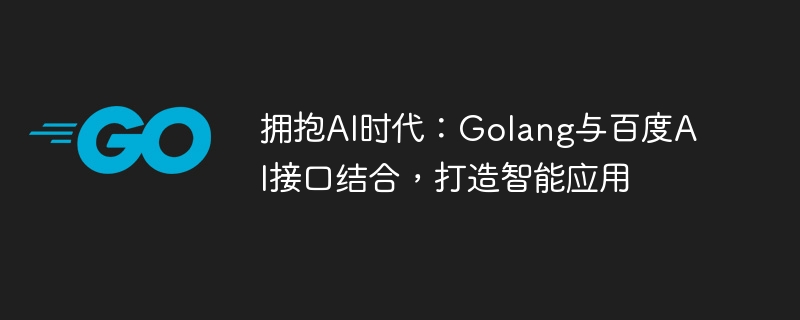Home >Backend Development >Golang >Embracing the AI era: Golang combines with Baidu AI interface to create intelligent applications
Embracing the AI era: Golang combines with Baidu AI interface to create intelligent applications
- WBOYWBOYWBOYWBOYWBOYWBOYWBOYWBOYWBOYWBOYWBOYWBOYWBOriginal
- 2023-08-17 12:54:23989browse

Embrace the AI era: Golang combines with Baidu AI interface to create intelligent applications
Introduction:
In recent years, the rapid development of artificial intelligence (AI) technology has Changed the way we live and work. As a simple and efficient programming language, Golang plays an important role in AI applications. This article will introduce how to combine Golang with Baidu AI interface, use the advantages of Golang to develop intelligent applications, and give corresponding code examples.
- Overview of Baidu AI Platform
Baidu AI platform provides a wealth of artificial intelligence technologies and services, including speech recognition, image recognition, natural language processing, etc. Developers can call these functions by calling Baidu AI's API interface. - Advantages of Golang
Golang is a fast, efficient, concurrency-safe programming language. Its unique concurrency model and powerful standard library make it ideal for developing AI applications. The following are several advantages of Golang:
- Concurrency safety: Golang’s concurrency primitives goroutine and channel can help developers easily implement concurrent operations and improve program efficiency.
- Fast compilation: Golang’s compiler has the characteristics of fast compilation and optimization, which can improve the execution speed of applications.
- Powerful standard library: Golang's standard library provides a wealth of functions and tools to facilitate developers to write and debug code.
- Steps to use Golang to call Baidu AI interface
The following takes the text recognition interface as an example to introduce the steps of how to use Golang to call Baidu AI interface:
Step 1: Register a Baidu AI account and create an application
First, you need to register an account on the Baidu AI platform and create an application. After creating an application, you will get an APP ID, API Key and Secret Key, which are used for subsequent interface calls.
Step 2: Golang installation dependent library
First, you need to install Golang's HTTP request library. You can use the following command to install:
go get github.com/levigross/grequests
Step 3: Golang code writing
Next, we can start writing Golang code to call Baidu AI interface. First, you need to import the required libraries:
import (
"fmt"
"github.com/levigross/grequests"
)Then, define a structure in the code to represent the request data to be sent:
type OCRRequest struct {
Image string `json:"image"`
}Next, write the function that calls the interface:
func CallBaiduAI(imagePath string) (string, error) {
url := "https://aip.baidubce.com/rest/2.0/ocr/v1/general_basic"
tokenUrl := fmt.Sprintf("%s?grant_type=client_credentials&client_id=%s&client_secret=%s",
"http://aip.baidubce.com/oauth/2.0/token", apiKey, secretKey)
resp, err := grequests.Get(tokenUrl, nil)
if err != nil {
return "", err
}
tokenData := struct {
AccessToken string `json:"access_token"`
}{}
err = resp.JSON(&tokenData)
if err != nil {
return "", err
}
headers := map[string]string{
"Content-Type": "application/json",
}
requestData := OCRRequest{
Image: imagePath,
}
resp, err = grequests.Post(url, &grequests.RequestOptions{
Headers: headers,
JSON: requestData,
})
if err != nil {
return "", err
}
result := resp.String()
return result, nil
}In the code, first use the API Key and Secret Key to obtain the access token (Access Token), and then use the certificate to call the Baidu AI interface.
Step 4: Call the interface and process the return result
Finally, we can call the above function in the main function and process the return result:
func main() {
imagePath := "test.jpg"
result, err := CallBaiduAI(imagePath)
if err != nil {
fmt.Println("调用百度AI接口失败:", err)
return
}
fmt.Println(result)
}In this sample code, we will The path of an image is passed to the CallBaiduAI function to call it, and the returned result is printed.
Conclusion:
This article introduces how to use Golang to call Baidu AI interface, and the advantages of Golang in AI application development. By combining Golang and Baidu AI, we can develop intelligent applications quickly and efficiently, bringing more convenience to people's lives and work. I hope readers can use it flexibly in actual projects, combine AI technology with the advantages of Golang, and create more application possibilities.
The above is the detailed content of Embracing the AI era: Golang combines with Baidu AI interface to create intelligent applications. For more information, please follow other related articles on the PHP Chinese website!
Related articles
See more- Golang determines whether it is a file or a folder
- Top ten artificial intelligence application scenarios in the medical field
- Use Python to connect with Baidu AI interface to make your program more interesting
- Use Python to implement Baidu AI interface docking to make your program smarter
- An in-depth guide to connecting Python with Baidu AI interface

